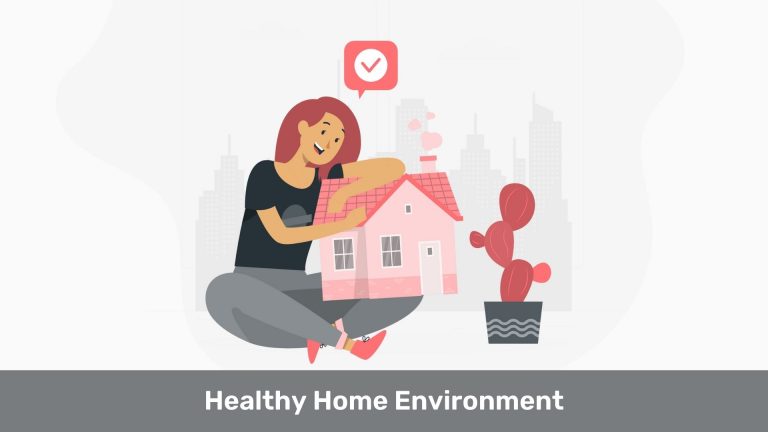Introduction
In an era where well-being takes center stage, the importance of cultivating a healthy home environment cannot be overstated. Beyond the physical shelter, your home is a canvas upon which you paint the colors of your lifestyle, and its design can significantly impact your overall health and happiness.
Did you know that the average person spends about 90% of their time indoors? This statistic underscores the profound influence that our living spaces have on our well-being. From the air we breathe to the choices we make in our daily routines, every aspect of our home contributes to the intricate tapestry of our health.
Indoor air quality can be two to five times more polluted than outdoor air, according to the U.S. Environmental Protection Agency. These startling figures prompt us to reevaluate the quality of the air we breathe within the confines of our homes, where we believe safety and comfort should be a given. It’s time to redefine our relationship with our living spaces, to transform them into sanctuaries that promote not just shelter, but true well-being.
This exploration into cultivating a healthy home environment is not just a trend; it’s a necessity in the contemporary landscape of health-conscious living. Get ready to embark on a journey that will not only redefine your living space but also revitalize your lifestyle. Welcome to a world where your home becomes the cornerstone of your healthy, happy life.
What is a Healthy Home?
A healthy home is a living environment that promotes and sustains the physical, mental, and emotional well-being of its occupants. It is a space consciously designed and maintained to minimize health risks, promote a sense of safety and security, and support a balanced and harmonious lifestyle.
A healthy home is more than just a physical structure; it’s a holistic concept that recognizes the interconnectedness of the living environment and its inhabitants, striving to create a space that enhances and sustains the health and happiness of those who call it home.
Characteristics of Healthy Home Environment
-
- Clean Indoor Air: Adequate ventilation and air quality are crucial components of a healthy home. Good ventilation helps reduce indoor pollutants such as allergens, mold, and harmful chemicals. Using air purifiers, maintaining HVAC systems, and incorporating indoor plants are common strategies to enhance air quality.
-
- Safety: A healthy home prioritizes safety measures to prevent accidents and injuries. This includes proper lighting, secure staircases, non-slip flooring, and childproofing for families with young children. Adequate fire safety measures, such as smoke detectors and fire extinguishers, are also essential.
-
- Natural Light and Lighting Design: Exposure to natural light has been linked to improved mood, sleep, and overall well-being. A healthy home maximizes natural light through well-designed windows and encourages a balance of natural and artificial lighting to create a comfortable and visually appealing environment.
-
- Adequate Space and Organization: Clutter and lack of space can contribute to stress and hinder physical activity. A healthy home is organized and provides sufficient space for various activities, promoting a sense of order and well-being.
-
- Connection with Nature: Integrating natural elements into the home environment, such as indoor plants, greenery, and natural textures, can have positive effects on mental health. This connection with nature contributes to a calming and rejuvenating atmosphere.
-
- Comfortable Temperature and Humidity Levels: Proper insulation, heating, and cooling systems help create a cozy and thermally efficient living space.
-
- Sound Control: Minimizing noise pollution within the home supports a healthy living environment. Considerations may include soundproofing, using soft materials to absorb sound, and creating quiet zones for relaxation.
Importance of Healthy Home Environment
A healthy home environment is of paramount importance as it significantly influences the overall well-being, physical health, and mental state of its occupants. Here are detailed reasons highlighting the importance of a healthy home environment:
Physical Health:
-
- Air Quality: A healthy home ensures good indoor air quality by minimizing pollutants, allergens, and toxins. Poor air quality can lead to respiratory issues, allergies, and other health problems.
- Safety Measures: Implementing safety measures reduces the risk of accidents and injuries within the home, promoting the physical well-being of occupants.
Mental Health:
-
- Stress Reduction: A well-designed and organized home reduces stress and promotes relaxation. Clutter-free spaces and comfortable environments contribute to a positive mental state.
- Natural Light and Nature Connection: Exposure to natural light and elements of nature within the home has been linked to improved mood, reduced stress, and enhanced overall mental health.
Disease Prevention:
-
- Hygiene Practices: A healthy home encourages and supports good hygiene practices, preventing the spread of diseases and infections within the household.
- Adequate Ventilation: Proper ventilation reduces the risk of mold growth, which can contribute to respiratory issues and other health problems.
Children’s Development:
-
- Safe Spaces for Play: A healthy home provides safe and stimulating spaces for children to play and explore, contributing to their physical and cognitive development.
- Learning Environment: An organized and conducive home environment supports effective learning and concentration for children and adolescents.
Quality of Sleep:
-
- Comfortable Temperature: Maintaining an optimal temperature and sleep environment contributes to better sleep quality, which is essential for overall health and cognitive function.
Long-term Health Impact:
-
- Preventing Chronic Conditions: A healthy home reduces exposure to environmental factors that may contribute to chronic conditions over time, such as respiratory diseases, allergies, and certain cancers.
Practical Tips for Creating a Healthy Home Environment
1. Keep It Smoke-Free

Creating a smoke-free environment within your home is a fundamental step toward ensuring optimal air quality and overall well-being. Cigarette smoke contains a multitude of harmful chemicals and pollutants that can have severe health implications for both smokers and non-smokers.
-
- Designated Outdoor Smoking Areas: If there are individuals who smoke, create designated outdoor areas away from entry points where smoking can take place. This helps prevent the infiltration of smoke into the home.
-
- Remove Smoking Paraphernalia: Discourage smoking by removing ashtrays and other smoking-related items from within the home. This not only serves as a visual cue but also reduces the convenience of smoking indoors.
-
- Regularly Ventilate the Home: Maintain good ventilation by opening windows and doors regularly to allow fresh air to circulate. This helps to disperse any residual smoke particles and improve overall indoor air quality.
-
- Consider Air Purifiers: Install air purifiers with HEPA filters to further reduce airborne particles, including those present in cigarette smoke. Place these purifiers in common areas and bedrooms for maximum effectiveness.
2. Limit Use of Bug Sprays

Minimize the reliance on conventional insect repellents that often contain synthetic chemicals. Instead, focus on adopting alternative and less harmful methods to deter insects and pests.
Natural Alternatives:
-
- Opt for natural insect repellents that use essential oils such as citronella, lavender, eucalyptus, or tea tree oil.
- Consider using citronella candles or essential oil diffusers to create a natural barrier against insects.
Seal Entry Points:
-
- Identify and seal any cracks or openings in windows, doors, and walls to prevent insects from entering the home.
- Ensure that screens on windows and doors are in good condition to keep bugs out.
Remove Standing Water:
-
- Eliminate sources of standing water around the home, as it can attract mosquitoes and other insects.
- Regularly empty and clean bird baths, flower pot saucers, and gutters to reduce breeding grounds for pests.
Natural Pest Control:
-
- Introduce natural predators of common pests, such as ladybugs for aphids or nematodes for soil-dwelling pests.
- Use diatomaceous earth, a non-toxic powder, as a natural barrier to control crawling insects.
Plant Insect-Repellent Herbs:
-
- Plant herbs like basil, mint, and rosemary around entry points to deter insects.
- Consider a small herb garden near windows or doors to act as a natural barrier.
Use Mesh Screens:
-
- Install mesh screens on windows and doors to allow for ventilation while keeping insects out.
- Ensure that screens are in good repair and replace them if damaged.
3. Regular Cleaning Routine

Establishing a regular cleaning routine is crucial for maintaining a healthy home environment.
Daily Tasks:
-
- Surface Cleaning: Wipe down high-touch surfaces daily, such as doorknobs, light switches, and countertops, using a mild disinfectant or a mixture of water and vinegar.
- Kitchen Maintenance: Wash dishes promptly, clean kitchen countertops, and sanitize kitchen surfaces to prevent the growth of bacteria.
Weekly Tasks:
-
- Vacuuming and Dusting: Vacuum carpets and rugs to remove dust, allergens, and debris. Dust surfaces, including shelves, furniture, and electronics, using dusting tools.
- Bathroom Cleaning: Clean bathroom surfaces, including sinks, countertops, and faucets. Scrub the toilet bowl and disinfect commonly touched areas.
Bi-weekly Tasks:
-
- Floor Care: Mop hard floors and clean grout lines to maintain cleanliness. Consider using floor cleaners suitable for the specific flooring material.
- Bedding and Linens: Wash bed linens, pillowcases, and curtains bi-weekly to ensure a clean and comfortable sleeping environment.
Monthly Tasks:
-
- Appliance Cleaning: Clean kitchen appliances such as the microwave, oven, and refrigerator. Remove accumulated dust from the coils of the refrigerator for efficient operation.
- Deep Vacuuming: Vacuum upholstered furniture and areas not covered during regular vacuuming, such as under furniture and along baseboards.
Seasonal Tasks:
-
- Window Cleaning: Clean windows and window sills inside and out to allow maximum natural light into the home.
- Closet Organization: Declutter and organize closets, donating or discarding items that are no longer needed. Vacuum and clean closet floors.
Annual or Semi-annual Tasks:
-
- Air Vent Cleaning: Schedule professional air duct cleaning to remove dust and debris, improving indoor air quality.
- Deep Carpet Cleaning: Hire a professional service or use a carpet cleaner to deep clean carpets and rugs.
4. Ventilate Well

It is the practice of ensuring proper air circulation within the home to maintain high indoor air quality. Adequate ventilation is essential for removing pollutants, allergens, and excess moisture, contributing to a healthier and more comfortable living environment.
Open Windows and Doors:
-
- Regularly open windows and doors to allow fresh outdoor air to enter the home.
- Create cross-ventilation by opening windows on opposite sides of the house to promote air exchange.
Use Exhaust Fans:
-
- Install and use exhaust fans in areas prone to moisture, such as bathrooms and kitchens.
- Run exhaust fans during and after activities that generate indoor pollutants, like cooking or showering.
Air Purifiers:
-
- Consider using air purifiers equipped with HEPA filters to capture airborne particles and improve air quality.
- Place air purifiers strategically in rooms where occupants spend a significant amount of time.
Regular HVAC Maintenance:
-
- Ensure that heating, ventilation, and air conditioning (HVAC) systems are well-maintained with regular filter changes.
- Schedule professional HVAC inspections to address any issues affecting air circulation.
Ventilate During Cleaning Activities:
-
- When using cleaning products or engaging in activities that release pollutants, ventilate the area by opening windows and doors.
- Allow fresh air to circulate and help disperse any lingering odors or fumes.
5. Mindful Use of Cleaning Products
The mindful use of cleaning products involves choosing and using household cleaners in a way that prioritizes the health and well-being of both the occupants and the environment.
Choose Non-Toxic Alternatives:
-
- Opt for cleaning products labeled as non-toxic, eco-friendly, and biodegradable.
- Look for certifications from reputable environmental organizations to ensure the products meet specific health and safety standards.
DIY Cleaning Solutions:
-
- Experiment with homemade cleaning solutions using simple ingredients like vinegar, baking soda, lemon, and essential oils.
- DIY solutions can be effective for various cleaning tasks without the use of harmful chemicals.
Spot Cleaning Instead of Over-Cleaning:
-
- Focus on spot cleaning areas that require attention rather than routinely cleaning entire surfaces.
- This approach reduces unnecessary exposure to cleaning agents and minimizes environmental impact.
Mindful Disposal of Cleaning Waste:
-
- Dispose of empty cleaning product containers properly, following local recycling guidelines.
- Consider eco-friendly disposal options for certain products, such as participating in community hazardous waste collection programs.
6. Natural Light Exposure

Maximizing natural light exposure within your home is a key element in creating a healthy and vibrant living environment. Natural light not only enhances the aesthetic appeal of a space but also positively influences physical and mental well-being.
-
- Open Curtains and Blinds: Keep curtains and blinds open during the day to allow sunlight to fill the space. Consider light-colored or sheer curtains that diffuse light without blocking it.
-
- Strategic Furniture Placement: Arrange furniture to allow natural light to reach deeper into the room. Avoid blocking windows with large or heavy pieces of furniture.
-
- Use Reflective Surfaces: Place mirrors or reflective surfaces strategically to bounce natural light around the room, making it feel brighter and more spacious.
-
- Choose Light Colors: Opt for light-colored paint and furnishings to enhance the reflection of natural light. Lighter tones on walls and furniture contribute to a more luminous atmosphere.
-
- Trim Trees and Shrubs: If possible, trim foliage around windows to allow more sunlight to enter the home. Prune outdoor plants strategically to avoid excessive shading.
-
- Consider Skylights or Sun Tubes: In spaces with limited access to windows, consider installing skylights or sun tubes to bring in natural light from above.
7. Indoor Plants

Indoor plants not only add a touch of natural beauty to your home but also contribute to a healthier living environment.
-
- Choose plants known for their air-purifying qualities, such as snake plants, spider plants, and pothos. These plants can help remove common indoor pollutants.
-
- Different plants have varying light needs. Place plants that thrive in low light, such as snake plants and ZZ plants, in areas with less sunlight. Provide brighter light for plants like succulents and cacti.
-
- Avoid overwatering by allowing the top inch of soil to dry out before watering. Adjust the watering frequency based on the specific needs of each plant. Some plants prefer consistently moist soil, while others prefer to dry out between waterings.
-
- Use containers with drainage holes to prevent water from pooling at the bottom, which can lead to root rot. Select pots that complement your home decor and provide adequate space for the plant to grow.
-
- Feed your plants with a balanced, water-soluble fertilizer during the growing season (spring and summer). Follow package instructions for proper dilution and application.
-
- Regularly remove dead or yellowing leaves to encourage new growth. Prune plants to maintain their shape and size, and to improve air circulation.
-
- Keep an eye out for pests like spider mites or aphids. Wipe leaves with a damp cloth to remove dust, which can attract pests. For more severe infestations, consider natural insecticidal soap.
-
- Choose plants that match your lifestyle and preferences. If you have pets, ensure that the plants you select are non-toxic to them.
8. Effective Waste Management

Effective waste management is a crucial aspect of creating a healthy home environment that not only benefits the immediate surroundings but also contributes to environmental sustainability.
Separate and Recycle:
-
-
- Bins for Recycling: Set up designated bins for recyclable materials such as paper, cardboard, plastic, glass, and metal.
-
Composting:
-
-
- Compost Bin: Introduce a composting system for organic waste, including kitchen scraps, fruit and vegetable peels, and yard waste.
- Use Compost for Gardening: Utilize the nutrient-rich compost in your garden to enhance soil quality and promote plant growth.
-
Minimize Single-Use Items:
-
-
- Reusable Alternatives: Replace single-use items like plastic water bottles, shopping bags, and disposable cutlery with reusable alternatives.
- Encourage Sustainable Practices: Educate family members about the environmental impact of single-use plastics and the importance of reducing their usage.
-
Electronic Waste Management:
-
-
- E-Waste Collection: Dispose of electronic waste responsibly by taking advantage of e-waste collection programs or designated drop-off locations.
- Donate or Recycle: Consider donating functional electronics or recycling them through certified e-waste recycling centers.
-
Reduce Food Waste:
-
-
- Meal Planning: Plan meals to reduce food waste and use leftovers creatively.
- Compost Food Scraps: Include food scraps in the compost bin to divert organic waste from landfills.
-
9. Limit Artificial Fragrances
Limiting artificial fragrances in the home is a practical and health-conscious approach to creating a healthier living environment. Artificial fragrances are often found in various household products, such as air fresheners, scented candles, cleaning products, and personal care items. While they may provide a pleasant scent, they can also introduce a range of synthetic chemicals into the indoor air, potentially causing irritation or triggering allergies in some individuals.
Choose Unscented or Naturally Scented Products:
-
- Opt for household and personal care products labeled as “unscented” or “fragrance-free” to minimize exposure to artificial fragrances.
- Consider products scented with natural essential oils for a more natural and subtle aroma.
Use Essential Oil Diffusers:
-
- Instead of traditional air fresheners or candles with synthetic fragrances, use essential oil diffusers to add pleasant scents to your home.
- Essential oils not only offer natural fragrances but also have potential therapeutic benefits, promoting relaxation and well-being.
Ventilate Spaces When Using Fragranced Products:
-
- If you choose to use scented products, ensure proper ventilation by opening windows or doors to allow fresh air circulation.
- Use these products sparingly to minimize the concentration of airborne chemicals.
DIY Natural Air Fresheners:
-
- Create your own natural air fresheners using ingredients like citrus peels, herbs, or spices.
- Simmering a pot of water with natural ingredients on the stove can provide a pleasant and chemical-free fragrance throughout your home.
.
10. Reduce Clutter

Reducing clutter is a key aspect of creating a healthy home environment. Clutter not only affects the physical appearance of a space but also has psychological and emotional implications.
Assessment and Sorting:
-
- Begin by systematically assessing each room and identifying items that are unnecessary or no longer serve a purpose.
- Sort items into categories such as keep, donate, recycle, or discard.
Declutter Room by Room:
-
- Take a systematic approach by decluttering one room at a time. This makes the process more manageable and less overwhelming.
- Prioritize areas that tend to accumulate clutter quickly, such as countertops, closets, and storage spaces.
Create Storage Solutions:
-
- Invest in practical storage solutions to keep items organized and easily accessible.
- Utilize storage bins, shelves, and baskets to group similar items and reduce visual clutter.
Minimalist Design Approach:
-
- Embrace a minimalist design philosophy by focusing on quality over quantity.
- Choose furniture and decor that serve a purpose and contribute to the overall aesthetics of the room.
One-In, One-Out Rule:
-
- Implement a rule where for every new item brought into the home, an old or unused item is removed.
- This helps maintain a balance and prevents the accumulation of unnecessary belongings.
Digital Declutter:
-
- Extend the decluttering process to digital spaces by organizing files, emails, and digital media.
- Delete or archive digital files that are no longer needed.
Regular Maintenance:
-
- Establish a routine for regular decluttering to prevent the accumulation of unnecessary items.
- Make decluttering a part of seasonal cleaning to ensure a consistently organized space.
Donate or Sell Unwanted Items:
-
- Donate items in good condition to local charities or organizations.
- Consider selling items online or hosting a garage sale to give them a second life.
Conclusion
The concept of a healthy home environment transcends mere aesthetics, extending into a realm where physical and mental well-being converge. By embracing intentional practices such as maintaining clean air quality, organizing spaces, and fostering positive habits, we lay the foundation for a living space that nurtures health and happiness.
A healthy home is a sanctuary where the elements of safety, comfort, and mindfulness coalesce, offering a refuge from the demands of the outside world. As we embark on the journey to create healthier living spaces, let us remember that every small change contributes to a cumulative impact on our overall quality of life.
May our homes be not only shelters but also catalysts for well-being, inspiring us to cultivate habits that resonate with vitality, balance, and contentment.





